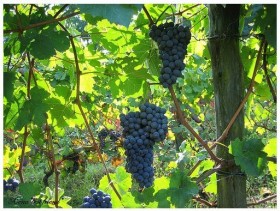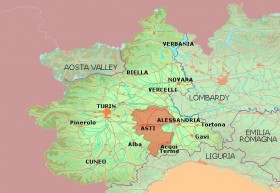Our friend Nancy Yos, of blog At First Glass, kindly shared with us her thoughts on a 2006 Vobis Tua Barbera d’Asti from Cantine Volpi. Nancy has been blogging for three years and her posts cover a wide range of wines and regions.
2006 Vobis Tua Barbera d’Asti
Producer: Cantine Volpi s.r.l., Tortona, Italy.
Light bodied, briny piquancy — tart, underripe raspberries – a little tarry or smoky — needs food
2nd day: mellowed and silkier 
Barbera d’Asti is both a grape and a DOC (Denominazione di Origine Controllata) but note that smaller case b-barbera is the grape, while capital B-Barbera d’Asti refers to the DOC, in the lovely Piedmont region of northwest Italy, spelled in Italian Piemonte. If Italy generally conjures up images of sunshine, rolling hills, Rome, Renaissance art, and pasta, for Piedmont in particular we ought to think instead of mountains (the Alps), rushing rivers (the Po), drifting fogs, of industrial Turin, and oddly enough of rice and corn cultivation. Both are major crops here (think risotto and polenta).
For its part, our glass of Barbera d’Asti represents a sort of little brother in a hierarchy of Piedmont’s red wines, ranking below the great Barbaresco and the still greater Barolo, both named for their places of origin within Piedmont but vinified from the nebbiolo grape — which in turn is named, it seems, for the drifting fogs (nebbia). Barbera can be either Barbera d’Asti, as we have here, or Barbera d’Alba; the latter is considered just slightly more of a heavyweight than the former, which seems to be why Barbera d’Asti is an everyday what’s-for-dinner wine in this part of Italy. Barbera d’Alba is also another DOC.
 Like so many Italian red wines, except its powerhouse big brothers Barbaresco and Barolo, a Barbera has that tart, light, berry-like flavor and a texture that seems a little grainy and rough, as if a few seeds of a fresh raspberry had found their way into the bottle and added their own little interesting zip there.
Like so many Italian red wines, except its powerhouse big brothers Barbaresco and Barolo, a Barbera has that tart, light, berry-like flavor and a texture that seems a little grainy and rough, as if a few seeds of a fresh raspberry had found their way into the bottle and added their own little interesting zip there.
Wine books always emphasize that Italian wines like this, tending to be thin, fresh, and acidic, are meant to be drunk with a meal and not treated as a free-standing cocktail, which is often how we drink syrupy, barbecued-fruit California cabernets or merlots. Karen MacNeil in The Wine Bible writes rapturously of the Piedmontese food that would go with a Barbera, or even better, with its muscular big brothers, Barbaresco and Barolo: heavy meat dishes, thick risottos, eggy fresh-made pastas dressed only with butter and sage leaves or, if you are lucky and are visiting in the fall, with shavings of white truffle from Alba. The truffle’s spectacular taste, MacNeil explains in a sidebar, has been studied in science labs, and has been found to derive from some sort of chemical that is also present in the testes of men and bulls. Experienced people hunt for them at night in secret, with specially trained white dogs. Wasn’t there a commercial jingle that used to assure us Italians have more fun?
Indeed they seem to, and another of Italy’s most fun wines, Moscato d’Asti, is also a product of this same Piedmont that gives us our very serious Barolos and our zippy Barberas. Of this, I can provide just one quick tasting note: it’s flying off the shelves in grocery stores now, outperforming even queen Chardonnay and princess Pinot Grigio.
Vobis Tua, we are told, is Latin for “as you like it.” We like it. Retail: about $10-$12.










